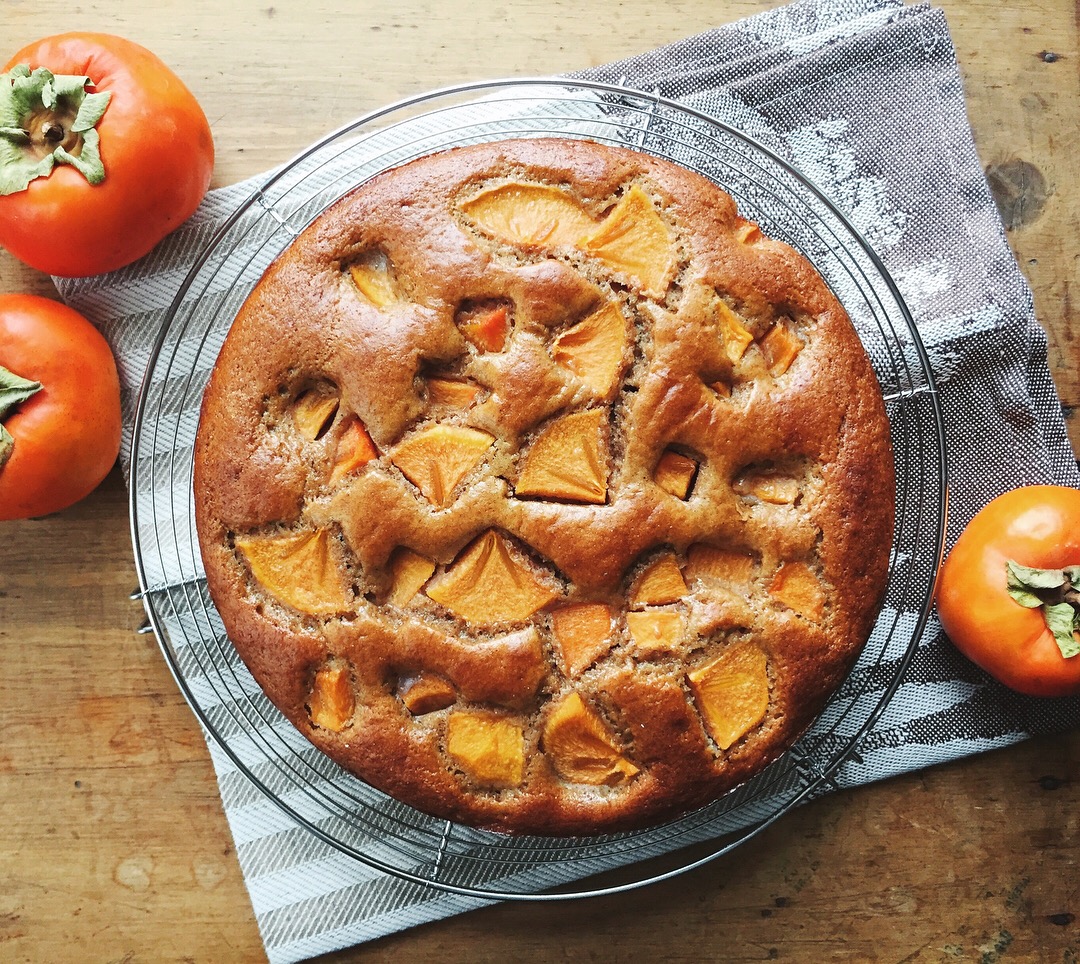Spiced Persimmon Cake
Our mom tried to introduce my sister and me to persimmons when we were little. She would buy a couple of egg-shaped hachiyas ~ known for their astringency ~ and let them sit in a bowl on the kitchen counter until they were fully ripe. She would slice one open and gave us each a sliver of the soft orange flesh. The tannins did a number on my tongue, as though it had suddenly grown fur. I would spit out the sliver and run to look at my tongue in the bathroom mirror.
It wasn't until November 2004 that I finally understood my mother's love for this autumnal fruit, "cachi" in Italian. My husband and I had taken our kids to Italy for the first time, and although I had spent many summers in Italy when I was growing up, that 2004 trip was also a first for me ~ my first time experiencing an Italian fall. The days were beautiful, chilly and often misty with light rain. The air in the hill towns smelled enticingly of smoke and grilled meat, and chestnuts were scattered like acorns on the ground. We ate warming soups and stews, and drank hot chocolate.
As we drove around the countryside, the kids wondered about the trees that dotted the brown landscape, the ones with orange fruits that hung like tiny lanterns from bare branches and glowed softly in the mist. Were they orange trees? We figured out, eventually, that they were persimmons, and for the first time I saw the fruit through my mother's eyes. Surely it evoked the autumns of her youth and provided a link, as food so often does, from those carefree prewar days of her Italian childhood to her life as a mom and schoolteacher in suburban New Jersey.
There is something evocative about persimmons, isn't there, just as there is about the quince and the pomegranate, those other fall fruits of a bygone era: their ancient provenance, their determination to survive through the centuries. They have an impenetrable quality, too. In the kitchen it's not always easy to unlock their possibilities.
In the U.S., wild persimmons (Diospyros virginiana) grow in the southeast, up through the mid-Atlantic and into the Midwest. Native Americans ate the fruit fresh and dried them for use in winter, and persimmon pudding remains a traditional Thanksgiving dish from North Carolina to Indiana.
A couple of weeks ago, when I spotted a bin of fuyus at the Twin Springs stall at my local farmers' market, I scooped up a handful and brought them home. I let them ripen, and when I sliced into one and tasted it, it was better than I remembered, delicate and softly sweet. Looking for an Italian recipe in which to use them, I came across one for persimmon cake in Giulia Scarpaleggia's book "I Love Toscana." It's my kind of cake, a simple, one-layer affair that needs only a dusting of powdered sugar or a dollop of whipped cream at serving time.
Giula's recipe calls for farro flour, which I didn't have, so I used a mix of all-purpose and whole-wheat, plus a little chestnut flour, which seemed to me an appropriate ingredient for a rustic fall cake. I added cinnamon and clove as well, warm spices that I knew would round out the delicate sweetness of the fruit. Giulia describes this cake as having the color "of dry autumn leaves." It's a cake that speaks softly of the beauty of the season.
A poem called "Persimmons," by Li-Young Lee
SPICED PERSIMMON CAKE
Makes one 9-inch cake
Ingredients
Butter and parchment for the baking pan
1/2 cup (65 g) unbleached all-purpose flour
1/4 cup (30 g) whole-wheat or rye flour
1/4 cup (30 g) chestnut flour
1/4 teaspoon fine sea salt, divided
1 teaspoon cinnamon
1/4 teaspoon ground cloves
3 eggs, separated, at room temperature
1 cup (200 g) brown sugar or muscovado sugar
1 cup whole-milk yogurt (not Greek)
1 teaspoon pure vanilla extract
1 ripe fuyu persimmon, peeled, sliced, and cut into wedges or pieces
Confectioners' sugar, for dusting
Whipped cream, for serving
Instructions
1. Heat the oven to 350° F. Coat a 9-inch cake pan with butter. Fit a 9-inch round of parchment paper into the bottom of the pan and butter it, too.
2. Sift the flours, 1/8 teaspoon salt, cinnamon, and cloves into a bowl. In a separate bowl, beat the egg yolks with the brown sugar until thick and creamy and the sugar is somewhat dissolved. It should be the color of pale coffee. Beat in the yogurt and vanilla extract. Stir the dry ingredients into the egg mixture just until combined.
3. Beat the egg whites and remaining 1/8 teaspoon of salt until stiff, glossy peaks form. Fold 1/3 of the whites into the batter to loosen it. Gently fold in the rest of the whites until no white streaks remain.
4. Pour the batter into the prepared cake pan and scatter the persimmon pieces evenly over the top. Bake 30 minutes, or until puffed and golden-brown on top. Test with a skewer or listen for bubbling sounds inside the cake; it is done when just a crumb or two cling to the skewer, or the bubbling sounds have subsided.
5. Let the cake cool on a rack for 20 minutes. Run a knife around the inner edge and gently invert the cake onto another rack or a plate. Remove the parchment and re-invert the cake onto the rack. Let it cool completely. Place it on a decorative plate and dust with confectioners' sugar at serving time. Cut into slices and serve with a dollop of softly whipped cream.


